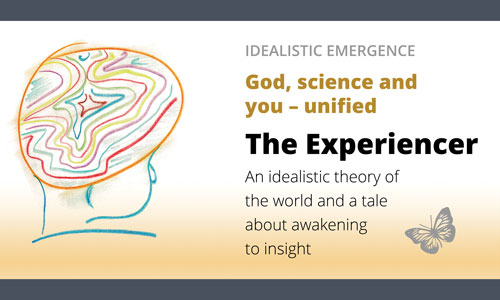15.8. Memorised, constant speed of light
The first speed the Experiencer conceptualised was the one that came from the distance and time between the first two points. Once speed was learned, it became decisive for the further distribution of time and space. This is the speed of light.
The ratio of distance to time gives speed. This relationship was defined for all eternity the first time distance and time – and then the concept of motion – was registered, interpreted and experienced.
The speed was memorised; it became knowledge.
Knowledge can, in theory, only disappear in two ways.
Either it is forgotten, i.e. it disappears by itself for some reason.
I said in the previous chapter that this is impossible because then the world would not have permanence; it could not last from one moment to another.
Knowledge can also be replaced; overwritten by new knowledge. If enough people tell you that what you think is yellow is actually red, you will, after a while, start believing in them, especially if you are alone in thinking yellow.
The strongest interpretation wins.
But note that this applies to the interpretation; what the concept, the idea «is». The quality of your experience of the colour, the quale, is unchanged, but you only get it now if someone shows you something red instead of something yellow.
It does not matter what name we give a quale, but it does matter what quale we associate with a concept.
The experience seems to be «truer» than the concept, which makes sense because an experience is to register, or «be alive», if you will, which is the primary function of the Experiencer.
We talked about motion and speed. Once a speed is learned, it can only be changed later if other speeds appear that overwrites the first.
But how would that happen when the first conceived speed was defined as a fixed relationship between time and distance?
It is impossible.
This first speed must therefore be the same as the speed of light, the speed we actually observe at this level. Because it came first and can never be redefined, it is constant.
As the Experiencer continues to imagine distances and time, the speed of light determines the magnitudes.
Are you an astrophysicist? Then I'll give you a little hint.
What has just been said explains why physics has no «fine-tuning» problem.
The absolute values we observe on the tiniest scales in the universe have not come about through a stroke of luck, nor in that God is behind and deciding – or something like that.
The values arose directly from the first two dots and the distance between them.
All later quantities in the entire universe are derived through emergence from this distance and the concepts that later followed.
The values are what they are.
Alternative sizes and values are impossible.
See?
The fact that there are also movements in the universe with lower speeds is due to other factors – other and later emergent interpretations that make the speed of light in that specific situation impossible.
Higher speeds are impossible because the speed of light is defined through the first and smallest possible distance – and the first and tiniest time interval. Anything less than this does not exist; consequently, higher speeds do not exist either. I'm now talking about the Planck units in physics.
Right now, we must get back on track.
The Experiencer currently possesses conceptual knowledge and associated experiences of points, time, distance and motion with constant speed, the speed of light.
Now I will say something important that you must keep with you in everything later in the book.
I'm talking about dots, distances, time and speed. I've begun to explain causal relationships as if I was there back then when it all started.
I shall immediately develop it further and draw parallels to what physics tells us. Many will say this is speculative because we can not know anything for sure until various professionals thoroughly examine it in a comprehensive process.
Even then, we may not be able to prove anything.
Then I must again remind you of the method we use. We collect clues. We induce.
I promote ideas about how it is conceivable that things are connected. It's a Gedankenexperiment, a thought experiment.
Then I build, as best I can, an unbroken chain of causal relationships from the very smallest to the very largest. We are still in the world of science, primarily physics.
Finally, I will show causal connections between the physical world and everything abstract and subjective.
Three things at once, gathered into one whole, where the same laws apply universally.
In short: The following is a suggestion for how things work. All things.
If I succeed, it's like a jigsaw puzzle. If everything seems connected, and there are trillions upon trillions of puzzle pieces, is it not likely that the solution is correct?
So, let's move on.
Where were we?
We have some dots, distances, time as «explanation» of distances – and speed which is an emergent interpretation of time and distance, i.e. something «more» that the two form together, the child of time and distance.
With this knowledge, there is now an explosion of the same, because this is the only knowledge that exists. It's everywhere.
With more and more points, accumulations, irregularities and patterns occur.
